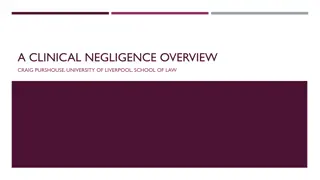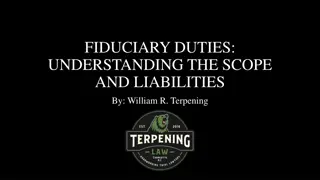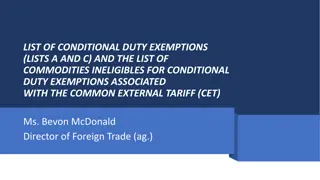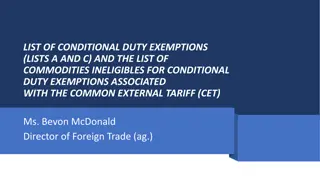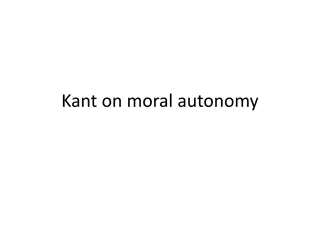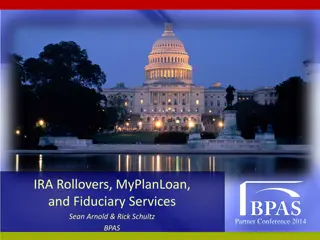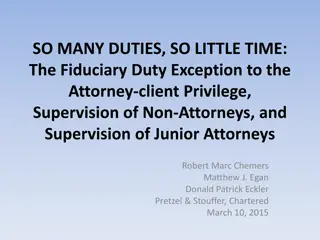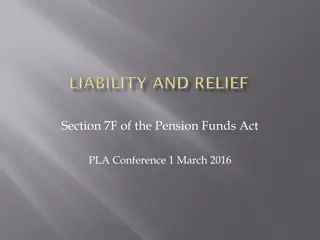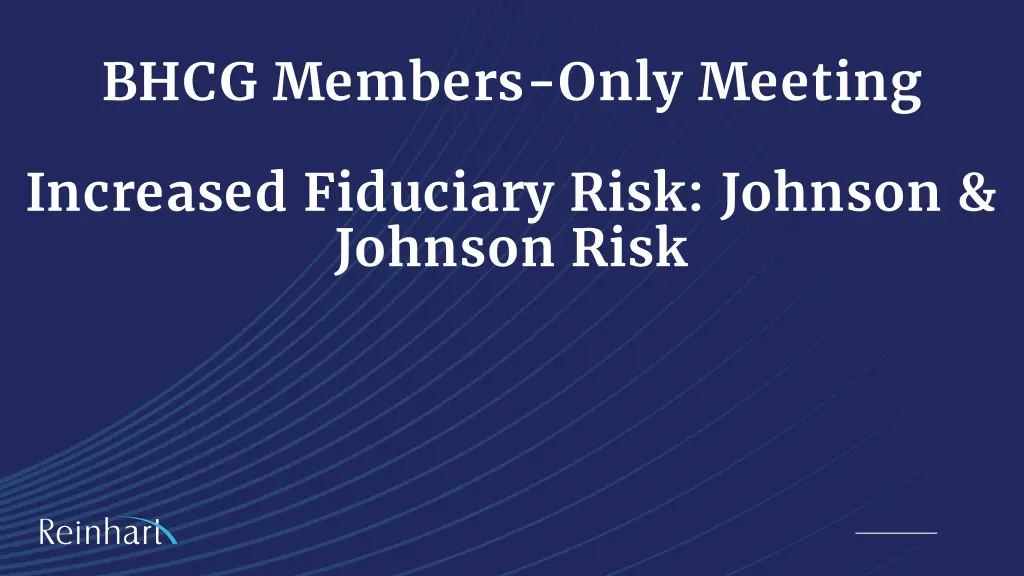
Understanding Fiduciary Risks in ERISA: Important Insights for Plan Sponsors
Gain valuable insights into ERISA fiduciary responsibilities and risks in retirement and health plans, including recent litigation and action strategies. Learn about the Settlor Exception and key considerations for plan sponsors to navigate fiduciary duties effectively.
Download Presentation

Please find below an Image/Link to download the presentation.
The content on the website is provided AS IS for your information and personal use only. It may not be sold, licensed, or shared on other websites without obtaining consent from the author. If you encounter any issues during the download, it is possible that the publisher has removed the file from their server.
You are allowed to download the files provided on this website for personal or commercial use, subject to the condition that they are used lawfully. All files are the property of their respective owners.
The content on the website is provided AS IS for your information and personal use only. It may not be sold, licensed, or shared on other websites without obtaining consent from the author.
E N D
Presentation Transcript
BHCG Members-Only Meeting Increased Fiduciary Risk: Johnson & Johnson Risk
Speakers / Moderator o Paul Page, Chief Legal Officer, Navitus Health Solutions o Stephanie Argentine, Chief People Officer & Head of Legal Affairs, Centivo o John Barlament, Shareholder, Reinhart Boerner Van Deuren o Dave Osterndorf, Chief Actuary, Centivo o Jeffrey Kluever, Executive Director, BHCG
Presentation Objectives oERISA fiduciary status and identification oFiduciary duties oRecent health plan litigation oClaims in J&J complaint oAction steps / strategies
ERISA in General oDue to perceived abuses by employers and other plan sponsors with respect to retirement and health plans, Congress enacted the Employee Retirement Income Security Act in 1974 oERISA imposes a large number of requirements on plan sponsors e.g., Form 5500; nondiscrimination rules (ERISA Section 510); mandatory coverage requirements (e.g., coverage for mastectomies) oERISA enforced by the federal government (Department of Labor ( DOL ) primarily) but also IRS (which deals with parallel tax code rules)
ERISA in General oCongress imposed among the highest known legal requirements under ERISA upon those who are Fiduciaries Concept of a Fiduciary is one who acts in the best interests of a third party who is relying upon the fiduciary e.g., the executor of a will, who cannot misinterpret the will and take benefits for himself/herself oEvery ERISA-covered Plan must have a Named Fiduciary and a Plan Administrator (often the same) Point person/entity who must oversee the Plan and satisfy various obligations (e.g., Form 5500; summary plan description distribution) oIn addition, certain people will be a Fiduciary based on their actions or responsibilities
Settlor Exception -Which Hat Are You Wearing? Settlor Fiduciary o Plan design o Amendment or termination o Employer contributions o Employee communications oPlan administration oImplementation of amendment / termination oHolding / investing/ using planassets oParticipant communications oParticipant claims Decisions in your role as an employee of the plan sponsor are not subject to ERISA Decisions in your fiduciary role are subject to ERISA s requirements
Fiduciary Liability Personal liability for: o Losses from breach of fiduciary duties o Breaches by other fiduciaries if: Your failure allowed the breach You knowingly participated in the breach You concealed the breach You do not take appropriate remedial action to correct the breach
What Are An ERISA Fiduciarys Core Duties? oExclusive Benefit Duty oPrudent Expert Duty oPlan Adherence Duty oDisclosure Duty oDuty to Monitor oNot violate other rules/laws oRetirement plans / funded health plans: diversify assets & maintain tax- qualified status of trust
Exclusive Benefit/Prudent Expert Rules oExclusive Benefit: Actions must be for the exclusive purpose of providing benefits to plan participants and beneficiaries and defraying the plans reasonable administrative expenses oActions taken with an eye toward plan sponsor s business goals (or other goals of third parties) may violate this duty oTry to avoid, limit or eliminate conflicts of interest oBe impartial in how you administer the plan
Exclusive Benefit/Prudent Expert Rules oPrudent Expert: Use the level of care that a prudent [person] knowledgeable about such matters would use in the same situation oIf you do not have this expertise yourself, then hire outside experts / educate yourself DOL Guidance: The fiduciary should appropriately consider all the facts and circumstances that apply e.g., ensure that investments are diverse Substantive prudence maybe 20% of the risk? Procedural prudence : A fiduciary s conduct is evaluated according to the result of a decision as well as the process used to make the decision Maybe 80% of the risk?
Procedural Prudence oIdentify factors relevant to the decision-making process oIdentify necessary fact-finding steps and background information oIdentify required expertise and knowledge needed; when necessary, consult with outside experts (e.g., accountant, actuary, legal counsel) oEvaluate relevant criteria oDocument the evaluation, decision and monitoring in writing
Plan Adherence/Disclosure Duties oActions must be in accordance with the: Plan document Summary Plan description Other documents under which Plan operates Can come up with respect to power to amend Plan and power to pick service providers oUnless it is contrary to ERISA oProvide all legally-required documents (e.g., summary plan descriptions)
Duty to Monitor / No Prohibited Transactions oFiduciary must review activities/processes of other fiduciaries to whom it delegates responsibility; also must assess delegated fiduciaries compliance with applicable law and with plan provisions oSo, sometimes it may be a good idea to audit service providers (e.g., TPAs and PBMs) oDepth and frequency must be consistent with the needs of plans in light of the complexity of operations and foreseeable risks oERISA generally prohibits the use of plan assets to pay a party in interest this is called a prohibited transaction o But important exceptions are available e.g., reasonable fees paid to service providers
Health Plan Fee Litigation oMust health plan fiduciaries manage fees that vendors are paid? oDefinitely yes , with respect to plan assets (e.g., participant contributions and amounts held in a trust or, perhaps, assets which should have been held in a trust) oDOL s 2015 publication Understanding Your Fiduciary Responsibilities under a Group Health Plan o When fees for services are paid out of plan assets, fiduciaries need to understand the fees [and] fees charged to a plan [must] be reasonable oLess clear for pure employer funds oExcessive fee litigation in the retirement plan area is extensive thousands of cases over the years
Health Plan Fee Litigation oExcessive fee litigation in the health plan space is relatively rare and sporadic. When it s occurred, it s usually been focused on lawsuits against TPA / insurer, not employer / plan sponsor oRecent examples include the following o2017: DOL sues, then settles with, MagnaCare. Claim was that TPA violated ERISA by charging plans an undisclosed markup over actual amounts it paid to providers o2019: The Depot, Inc. v. Caring for Montanans (9thCir.). Claim was that insurer charged extra fees and used those as a kickback to local chamber of commerce o2010s: BCBS of Michigan pays hundreds of millions over hidden fees (lawsuits primarily brought by self-funded employer clients) o Did that help fend off participant lawsuits against employers, for failing to monitor? o2023: Plaintiff-side law firm advertises in this space (Petsmart, Target, State Farm were targets)
Health Plan Fee Litigation oFebruary 2024: Erie County sues diabetes drug manufacturers and PBMs (CVS, ESI, OptumRx) over insulin pricing scheme (high costs that its self-funded health plan paid for insulin) oFebruary 2024: Johnson and Johnson ( J&J ) hit with sophisticated, detailed complaint from employee who lives in Madison, WI oClaims mismanagement of plan demonstrated by high-cost prescription drugs o E.g., plan agreed to pay (allegedly) $10,239 for a 90-day supply of generic form of drug Aubagio, supposedly available for $40 - $77 at a local grocery store / pharmacy o Also, claims here apparently paid through a trust raising fiduciary risks oComplaint includes summary chart of 42 drugs with alleged cost of $28,000, for which J&J plan agreed to pay $167,000 (a markup of 498% ) oComplaint attacks process by which PBM (ESI) was hired o Focus on transparent pricing v. spread pricing o Nice shout-out in favor of Navitus
Health Plan Fee Litigation oJ&J will likely have some good defenses oJust because drugs were priced highly does not mean that participant was harmed o Rebates may have brought down price o Plan may have paid cost (not participant) o PBM may have steered enrollee to other, alternative, cheaper drugs and not been worried about list price of certain high-cost drugs o Not clear that enrollee here was actually harmed not clear that she purchased any high-cost drugs o In other words, this particular enrollee may not have standing to sue o This claim was made in March 2024 by J&J lawyers in a court filing o In April 4, 2024 response, plaintiff s lawyer claimed that plaintiff was harmed because amount plaintiff paid in premiums and out-of-pocket costs was inflated by [J&J s] conduct
Health Plan Fee Litigation oAlso attacked consultants / brokers as having a financial bias oCited to media reports that consultants act as gatekeepers and demand commissions oAllegedly, consultant blocked PBM from employer client unless consultant received $1 - $6.50 per prescription that was to be processed under plan oAlso that consultants may share in rebates that PBMs receive from drug manufacturers oClaims that some brokers, while purporting to manage an open RFP process for their client prescription-drug plans, will refuse to solicit bids from PBMs that decline to offer the [broker] kickbacks or other forms of indirect compensation oWill CAA price transparency rules help reveal this to employers? If so, what should employers do about this?
Panel Discussion / Audience Questions oWhat are strategies that plan sponsors should take in light of these allegations? oWhat steps have plan sponsors taken in the retirement plan context? Can those steps / concepts be used in the health plan context? oPlan document / summary plan description changes which can help? o Limitations periods (e.g., all lawsuits must occur within 6 months or a year after harm occurs)? o Venue provisions (e.g., force lawsuits to occur in a more-favorable court, not a plaintiff- friendly court)?

